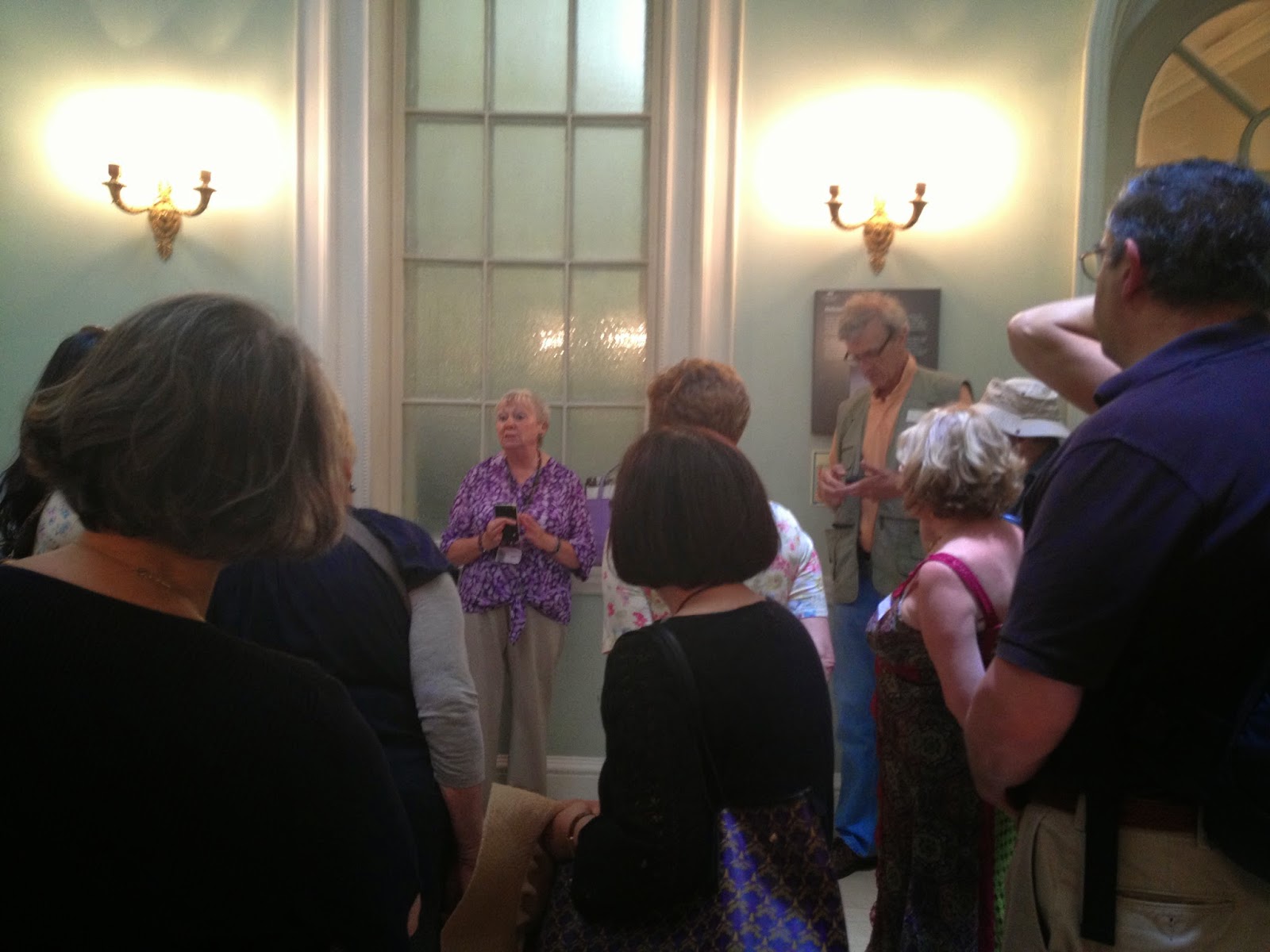Exploring Somerset House
Our time in London was running out, but we still managed to explore new places and make the most of the time we had left. On my aunt's suggestion, the four of us decided to visit "Somerset House." Somerset House is a rather large neoclassical building complex that serves many functions, such as: art museum, government departments, and has been used as a film location many times (GoldenEye, The Duchess, Sleepy Hollow, Love Actually). My aunt had learned about this place from my cousins and it seemed really cool.
Getting to Somerset House was super easy --- a simple tube ride away. When we emerged from the tube at Temple, we walked parallel to the Victoria Embankment. On our way to Somerset House, I paused and walked on top of the Temple tube stop to get a better view of the Embankment. As I walked up the stairs, on my way to the roof, I noticed a fairly large group of people chatting. I didn't pay much attention until I suddenly realized that the woman in the center was the hilarious comedienne Joanna Lumley! What are the chances! I very casually snapped a picture, enjoyed the view, and continued on my way to Somerset House.
At the time I was not so aware of this, but after having done a bit of Wikipedia research, I have learned that Somerset House has quite an impressive history, dating back to the 16th Century! The site of Somerset House used to belong to Edward Seymour, Earl of Hertford, back in 1539. In 1547, when Edward VI came to the throne, Seymour was made the Duke of Somerset and Lord Protector. With his newfound prestige, Seymour began to buy the surrounding buildings and began to construct an ostentatious home for himself. Unfortunately for him, in 1552, Seymour was overthrown and executed on Tower Hill. His estate, "Somerset House," became the property of the crown and served as Queen Elizabeth I's resident during the reign of her half-sister, Queen Mary I.
After Queen Elizabeth I, the Somerset House was still used as a royal residence for queens consorts. Notable residents include: Anne of Denmark (married to James I), Henrietta Maria of France (married to King Charles I), and Catherine of Braganza (married to King Charles II). Royal occupation at Somerset House was briefly disrupted by the English Civil War (1642~1651). After the "Glorious Revolution" in 1688, Somerset House was abandoned and and by the 18th century, its association with the royal family had been cut. By 1775, demolition of Somerset House had begun, but it was not completed.
In the same year, Parliament passed an act, which saved Somerset House and turned it over to the government. The mansion was to be used to house public offices. The house was renovated and refurbished.
In the 19th century, King's College London was erected to the east of Somerset House. Later, the western and southern section of the building was secured by the Admiralty. Somerset House also went on to house several Royal Societies.
During the Second World II, Somerset House suffered during the Blitz. The building lost sixteen rooms, the Nelson Stair (handsome rotunda staircase), and suffered other minor blasts in the South wing. In the West Wing, another 27 rooms were destroyed and countless numbers of windows were shattered and balustrades demolished. By 1950, most of the damage was repaired and Somerset House was restored to its former glory!
The Dead House is a massive underground room, and I suspect network of tunnels that runs under the courtyard. Whilst I am not entirely sure of the Dead House's purpose, what I can tell you is that some very old tombstones are on display there. Dad and I were a bit bad, and snuck off whilst the tour guide was talking, hence my lack of knowledge about this place. There were lots of cold, dark, and abandoned rooms, so we decided it would be more fun to play "zombies." Dad pretended to be a zombie and I took lots of pictures. Very professional…I know...
Getting to Somerset House was super easy --- a simple tube ride away. When we emerged from the tube at Temple, we walked parallel to the Victoria Embankment. On our way to Somerset House, I paused and walked on top of the Temple tube stop to get a better view of the Embankment. As I walked up the stairs, on my way to the roof, I noticed a fairly large group of people chatting. I didn't pay much attention until I suddenly realized that the woman in the center was the hilarious comedienne Joanna Lumley! What are the chances! I very casually snapped a picture, enjoyed the view, and continued on my way to Somerset House.
Oh hello there, Joanna Lumley!
At the time I was not so aware of this, but after having done a bit of Wikipedia research, I have learned that Somerset House has quite an impressive history, dating back to the 16th Century! The site of Somerset House used to belong to Edward Seymour, Earl of Hertford, back in 1539. In 1547, when Edward VI came to the throne, Seymour was made the Duke of Somerset and Lord Protector. With his newfound prestige, Seymour began to buy the surrounding buildings and began to construct an ostentatious home for himself. Unfortunately for him, in 1552, Seymour was overthrown and executed on Tower Hill. His estate, "Somerset House," became the property of the crown and served as Queen Elizabeth I's resident during the reign of her half-sister, Queen Mary I.
After Queen Elizabeth I, the Somerset House was still used as a royal residence for queens consorts. Notable residents include: Anne of Denmark (married to James I), Henrietta Maria of France (married to King Charles I), and Catherine of Braganza (married to King Charles II). Royal occupation at Somerset House was briefly disrupted by the English Civil War (1642~1651). After the "Glorious Revolution" in 1688, Somerset House was abandoned and and by the 18th century, its association with the royal family had been cut. By 1775, demolition of Somerset House had begun, but it was not completed.
In the same year, Parliament passed an act, which saved Somerset House and turned it over to the government. The mansion was to be used to house public offices. The house was renovated and refurbished.
In the 19th century, King's College London was erected to the east of Somerset House. Later, the western and southern section of the building was secured by the Admiralty. Somerset House also went on to house several Royal Societies.
During the Second World II, Somerset House suffered during the Blitz. The building lost sixteen rooms, the Nelson Stair (handsome rotunda staircase), and suffered other minor blasts in the South wing. In the West Wing, another 27 rooms were destroyed and countless numbers of windows were shattered and balustrades demolished. By 1950, most of the damage was repaired and Somerset House was restored to its former glory!
Somerset House
Nothing prepared me for the splendor of this truly luxurious and ginormous house. Granted, I'm sure Somerset House was not this big during Seymor's day, but I still, I'm sure this is what he had envisioned!
The House is square shaped with a massive courtyard in the middle. During the summer, there is a giant fountain that you can run through and enjoy. When we visited, the fountains, which alternate with height and intensity, they were packed with happy little children! I had so much fun just watching them play in the water. I learned that during the winter time, the fountains are replaced with an ice rink! How cool! I also learned that during the summer, Somerset House does film screenings in the courtyard, where they have a massive screen and projector and it's quite popular. I imagine it's a bit like the film screenings in Bryant Park.
An all girls school had a field trip and the little girls had a blast running through the fountain!
Another view of Somerset House
Cafe on the back patio, which looks out onto Victoria Embankment and the Thames
Cafe #2, adjacent to the first cafe
The house is huge, so we decided to take a guided tour. Makes sense, right? I have been on many tours before, but this one takes the cake. I don't want to be cruel, but the tour of Somerset House was one of the worst tours I've ever been on! It wasn't that the building wasn't pretty or the history was boring or the art was boring --- it was the tour guide! I suspect it was her first day, or at least early days for her, because she didn't quite seem to know what was going on. She was reading off her notes a lot, which is fine, but she was just so hard to hear. She had a knack for constantly picking the worst places to stop and chat (i.e. busy corridors), she didn't project (so you could barely hear her), and she seemed to get a bit flustered… I felt a bit bad, but after the first 5 minutes or so of the tour, I just tuned out.
Our tour guide, introducing us to Somerset House. Too bad I couldn't hear a thing!
Very interesting modern staircase
Stairwell leading to the "Dead House." It's not a morgue, I promise.
In my opinion, the most interesting part of the tour was the "Lightwells" and the "Dead House." This may sound a bit ominous and for some reason I thought this was morgue or crypt, but it's not. Well, not entirely. To get to the Dead House, you must pass through the "Lightwells", which consist of "soaring spaces with graceful staircases and hidden nooks and crannies." (taken from Somerset House website). We were told that the Lightwells have been used to recreate Victorian London in "Jack the Ripper" related films and was also used in the 2009 Guy Ritchie film Sherlock Holmes. If you visit the Lightwells, you can easily see why. It's got the dark eeriness that you associate with Victorian era Whitechapel.
Walking through the Lightwells
The Dead House is a massive underground room, and I suspect network of tunnels that runs under the courtyard. Whilst I am not entirely sure of the Dead House's purpose, what I can tell you is that some very old tombstones are on display there. Dad and I were a bit bad, and snuck off whilst the tour guide was talking, hence my lack of knowledge about this place. There were lots of cold, dark, and abandoned rooms, so we decided it would be more fun to play "zombies." Dad pretended to be a zombie and I took lots of pictures. Very professional…I know...
The Dead House
Old tombstones
My time at Somerset House was very interesting. My aunt later found out that in fact my cousins wanted us to visit the "Courtauld Gallery", which is an art museum housed at Somerset House. Oops. Although the tour was terrible and we didn't visit the Courtauld Gallery, I still enjoyed myself. I got to visit a location that I had never heard of, I was able to bask in the glory of a splendid neoclassical mansion, and I got to be with my family --- what could be better?!

















Comments
Post a Comment